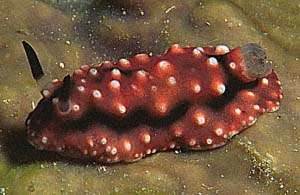
Paradoris liturata
(Bergh, 1905)
Order: NUDIBRANCHIA
Suborder: DORIDINA
Family: Discodorididae
DISTRIBUTION
Specimens have been reported (see messages below) from Papua New Guinea, Indonesia, and Thailand.
PHOTO
Found at depth of 90ft, in open, on a wall, crawling over dead coral encrusted with coralline algae. It was not feeding when found. 2.5 cm live. Pulau Hoga Island, Tukangbesi Archipelago, SE Sulawesi, Indonesia. PHOTO: Adam Powell.
RELATED TOPIC
Mimics of Phyllidiella pustulosa
Note added 5 March 2007: This species was previously known on the Forum as Discodoris? liturata Bergh, 1905
This remarkable mimic of the phyllidiid Phyllidiella pustulosa has been commented on by a number of researchers in recent years. Richard Willan ( message #350 ) has studied the holotype of Bergh's Discodoris? liturata and considers them to be the same, but not a species of Discodoris. Bergh's material was collected from off Sumbawa Island, Indonesia, during the Siboga Expedition. he notes its similarity to Phyllidiella.
Dayrat (2006) shows that it is a species of Paradoris.
See also Aldisa erwinkoehleri, a Phyllidia mimic from Thailand.
See also Aldisa williamsi, another phyllidiid mimic from Indonesia.
-
Bergh, L.S.R. (1905) Siboga Expedition Monograph, 50: 106-7, Pl 14, figs 15-20.
-
Dayrat, B. (2006) A taxonomic revision of Paradoris sea slugs (Mollusca, Gastropoda, Nudibranchia, Doridina). Zoological Journal of the Linnean Society, 147 (2): 125-238.
-
Willan, R.C. (1989) Ultrastructure of a remarkable new mimetic dorid nudibranch (Gastropoda: Opisthobranchia). Abstracts, 10th International Malacological Congress, Tubingen 1989.
-
Gosliner, T.M. & D.W. Behrens 1990. Special resemblance, aposematic coloration and mimicry in opisthobranch gastropods. Pages 127-138, pl 8-10 In: Wicksten, M. (Compiler) Adaptive Coloration in Invertebrates. Texas A&M University, College Station, Texas, 138 pp.,11 plates.
Rudman, W.B., 1998 (December 1) Paradoris liturata (Bergh, 1905). [In] Sea Slug Forum. Australian Museum, Sydney. Available from http://www.seaslugforum.net/find/disclitu
Related messages
Paradoris liturata - amazing phyllidiid mimic
July 3, 2008
From: Sean Kearney

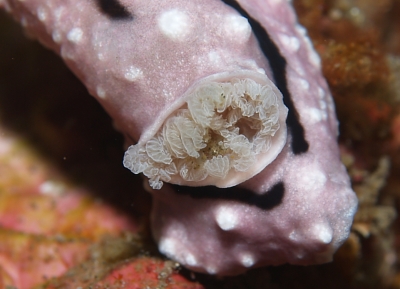
Concerning message #14885:
Dear Bill,
At first glance I thought this to be a damaged P. rudmani. Closer examination revealed gills. I waited as long as I could for the gills to extend, until I had to ascend.
Locality: Lembeh Strait, Celebes Sea, sandy slope. Length: 60 mm. Photographer: S. Kearney.
Another terrific Lembeh nudi trip.
Thanks for the wonderful forum,
Sean
skearney@dc.rr.com
Kearney, S., 2008 (Jul 3) Paradoris liturata - amazing phyllidiid mimic. [Message in] Sea Slug Forum. Australian Museum, Sydney. Available from http://www.seaslugforum.net/find/21652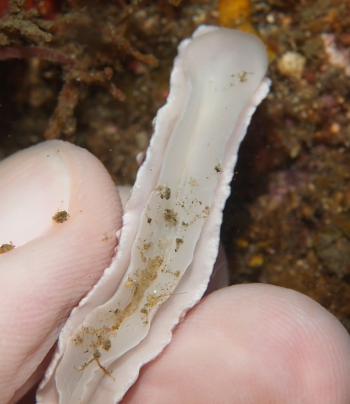
Dear Sean,
Thanks for this interesting record. I think I will bite the bullet and identify this as Paradoris liturata rather than Paradoris cf. liturata . This amazing mimic of Phyllidiella is crying out for some research. I guess it's reasonable to assume that P. liturata is the mimic and species of Phyllidiella are the model in this case. Which raises the question of just how could a mimic is this animal? Does it just rely on looking like a distasteful and noxious Phyllidiella, or does it also store distasteful and noxious molecules in its skin to protect it from predation as well? And does it have behaviouarl similarities as well. Phyllidiids are well known as the nudibranchs most often encountered in daylight, the suggestion being that their poisonous skin is a deterrent to daytime fish attack. It would be interesting to know if this species of Paradoris also makes little attaempt to hide itself during day time.
Best wishes,
Bill Rudman
Phyllidia mimc from SE Sulawesi
September 28, 2005
From: Fuensanta Candela-Castillo
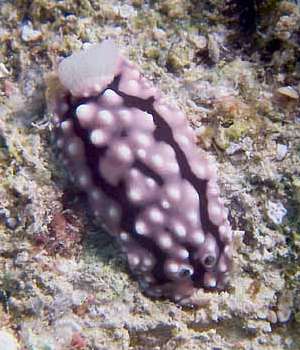
Dear Dr Rudman,.
A few days ago (19 September 2005) I photographed this specimen in Pinkie's Wall, close to Wakatobi in Southern Sulawesi. The slug was found at about 10 m depth on a coral wall and measured about 3-4 cm. It is clearly a phyllidiid mimic, but I don't think it fits the features of any of the two Aldisa species mentioned in the mimicry page. I was wondering if you could help identifying it.
Thank you in advance.
Fuensanta Candela-Castillo
Brussels, Belgium
fcandela@skynet.be
Candela-Castillo, 2005 (Sep 28) Phyllidia mimc from SE Sulawesi. [Message in] Sea Slug Forum. Australian Museum, Sydney. Available from http://www.seaslugforum.net/find/14849Note added 5 March 2007: This species, previously known on the Forum as Discodoris? liturata Bergh, 1905 is now placed in the genus Paradoris.
Dear Fuensanta,
This is another fascinating mimic of the phyllidiids. The bushy gills are a real giveaway though. It is on the Forum as Discodoris? liturata, because at last count the generic position of the species was not definite. I try and keep up with the latest literature but if anyone knows of a recent publication involving this species, could they let me know please.
Best wishes,
Bill Rudman
Phyllidiella mimic from Bali
March 15, 2002
From: Stuart Hutchison
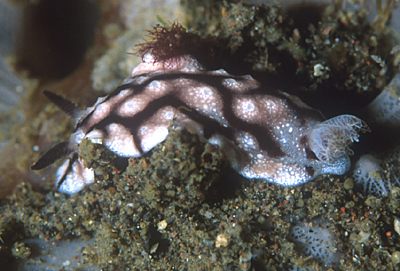
Hi Bill,
This guy looks remotely similar to one of your Chromodoris geometrica shots, but I'm not convinced. I haven't found anything quite like it in the books yet.
40mm long from Bali, Indonesia on 25 Oct 2001 at 15m depth.
Regards,
Stuart
stuart@stuarthutchison.com.au
Hutchison, S., 2002 (Mar 15) Phyllidiella mimic from Bali. [Message in] Sea Slug Forum. Australian Museum, Sydney. Available from http://www.seaslugforum.net/find/6297Note added 5 March 2007: This species, previously known on the Forum as Discodoris? liturata Bergh, 1905 is now placed in the genus Paradoris.
Thanks Stuart,
I guess this is also the animal that has been identified as Discodoris? liturata. It looks a lot thinner than Nishina's specimens but I think its probably because yours is on the move. Of course there is always the possibility that it is different, even the animal I am calling Doris sp. 3.
Best wishes,
Bill Rudman
Phyllidiella mimic from Mabul Island
March 14, 2002
From: Nishina Masayoshi
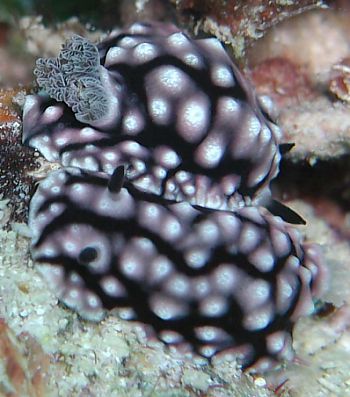

Dear Bill,
I photographed those attached images on 2 June 2001 at Mabul Island, Sabah, Malaysia.
I thought that they were a kind of Phyllidiella but soon I noticed that they have gills!
Length:about 25mm
Best Regards,
Nishina Masayoshi
http://umiushi.zive.net/index.html
nishina@wips.co.jp
Masayoshi, N., 2002 (Mar 14) Phyllidiella mimic from Mabul Island. [Message in] Sea Slug Forum. Australian Museum, Sydney. Available from http://www.seaslugforum.net/find/6426Note added 5 March 2007: This species, previously known on the Forum as Discodoris? liturata Bergh, 1905 is now placed in the genus Paradoris.
Dear Nishina,
Thanks for these wonderful photos. I think this is the animal we are identifying with Bergh's Discodoris liturata. According to Richard Willan, who has looked at its anatomy, it is not a Discodoris, but whether it is another Aldisa mimicking phyllidiids, like Aldisa williamsi and Aldisa erwinkoehleri, I wouldn't know.
Best wishes,
Bill Rudman
Is this Discodoris? liturata or another species?
December 18, 1998
From: Bernard Picton

Hi Bill,
Lindsay was telling me about the Phyllidia mimic, so I took a look at the one we got last year. I enclose a scan. Again, Hoga Is (Sulawesi, Indonesia). This seems to be a different species, but of course there seems to be a strong selection pressure to look like a Phyllidia, they must be really awful to eat!!
Bernard
bernard.picton.um@nics.gov.uk
Picton, B., 1998 (Dec 18) Is this Discodoris? liturata or another species?. [Message in] Sea Slug Forum. Australian Museum, Sydney. Available from http://www.seaslugforum.net/find/404Note added 5 March 2007: This species, previously known on the Forum as Discodoris? liturata Bergh, 1905 is now placed in the genus Paradoris.
Thanks for the pic Bernard.
Hopefully it is not a different species but just a colour form. I know if it were a different species it would be another spectacular example of mimicry but it would be a nomenclatural mightmare. Not only would it probably be impossible to decide which is Bergh's species, but it would make life difficult for fieldwork identifications in the future. Whatever the case, they are really amazing mimics. ... Bill Rudman.
More on the Phyllidiella mimic
December 7, 1998
From: Lindsay Warren
Dear Bill
I have just received all the data sheets on opisthobranch specimens collected in the Tukang Besi. Please find below data regarding the Phyllidiella impersonator:
Size: 2.5 cm live. Found at depth of 90ft, in open, on a wall, crawling over dead coral encrusted with coralline algae. It was not feeding when found.
The pustules featured a pink base as the rest of the dorsum, translucent white tip with solid white spots (flat) between pink and translucent areas. If it would help, I can scan in the diagrams and comments.
I hope the above helps. I will be emailing more shots tomorrow once I can access the disc I need. Many thanks for your help.
With best wishes
Lindsay
Lindsay Warren
100014.2112@compuserve.com
Warren, L., 1998 (Dec 7) More on the Phyllidiella mimic. [Message in] Sea Slug Forum. Australian Museum, Sydney. Available from http://www.seaslugforum.net/find/362Note added 5 March 2007: This species, previously known on the Forum as Discodoris? liturata Bergh, 1905 is now placed in the genus Paradoris.
Thanks Lindsay,
The extra information is very useful, though I don't think we need the notes and diagrams. Look forward to some more photos,
Bill Rudman.
Re: Phyllidiella mimic
December 1, 1998
From: Richard Willan
Dear Bill,
When I was in Madang, Papua New Guinea, in 1988 I did discover a dorid that mimics Phyllidiella pustulosa and I gave a presentation on this at the Unitas Malacologia Congess in Tubingen in 1989. So the only publication to date is in the Proceedings of that Congress. Since then I have examined the holotype of Discodoris liturata Bergh, 1905, which is in Amsterdam, and this is the same species but the genus is not Discodoris. Some day I'll get around to publishing this superb example of mimicry and the taxonomy of the mimic.
A picture of the mimic (named only "undescribed cryptobranch dorid") and model, plus several other putative mullerian mimicry associations involving opisthobranchs, was published in an interesting paper by Gosliner & Behrens (1990) and it would be appropriate to put this reference on the Forum too. The similarity of the mimic and Phyllidiella pustulosa is quite extraordinary!
Cheers,
Richard Willam
Note added 5 March 2007: This species, previously known on the Forum as Discodoris? liturata Bergh, 1905 is now placed in the genus Paradoris.
Thanks Richard,
I've put the relevant references on the Fact Sheet
Bill Rudman.
An amazing mimic of Phyllidiella pustulosa
December 1, 1998
From: Lindsay Warren

Dear Bill,
Here is another picture from Pulau Hoga Island, Tukangbesi Archipelago, SE Sulawesi, Indonesia. The photo is Adam Powell's.
I am very excited about this particular one. When I collected it I thought it was a colour variant of Phyllidiella pustulosa - it has the same tough body but rather different markings. Having left it in a dish for a while, I took a closer look under the microscope as one of the pustules at the rear seemed to be opening up. Before taking a closer look I thought this was probably the anus but imagine my surprise when I saw the small grey gills which had been completely retracted till then!
If you have any problems with the photos please let me know - they were scanned in at a larger size but I reduced them to send to you.
Once again, many thanks for all your help and your interest.
With best wishes
Lindsay Warren
100014.2112@compuserve.com
Warren, L., 1998 (Dec 1) An amazing mimic of Phyllidiella pustulosa. [Message in] Sea Slug Forum. Australian Museum, Sydney. Available from http://www.seaslugforum.net/find/348Note added 5 March 2007: This species, previously known on the Forum as Discodoris? liturata Bergh, 1905 is now placed in the genus Paradoris.
Dear Lindsay,
Firstly the photos are great..especially when you send interesting animals like this! I vaguely remembered seeing or talking to someone about this so I sent queries to David Brunckhorst and Richard Willan. Their replies, which you can see above, extend the known range of the species and sort out its name, if not its relationships.
It certainly is a good mimic.
Bill Rudman.
Re: Phyllidiella mimic
December 1, 1998
From: David J. Brunckhorst
Note added 5 March 2007: This species, previously known on the Forum as Discodoris? liturata Bergh, 1905 is now placed in the genus Paradoris.
Hi Bill,
Yes I collected a couple of specimens in Thailand and its radula when I looked at it was a bit unusual I recall (sorry vague memory is of about 10 years ago now). I gave the specimens to Richard Willan.
Sorry I can't be more helpful
Dr David J. Brunckhorst
dbrunckh@metz.une.edu.au
Brunckhorst, D.J., 1998 (Dec 1) Re: Phyllidiella mimic. [Message in] Sea Slug Forum. Australian Museum, Sydney. Available from http://www.seaslugforum.net/find/349